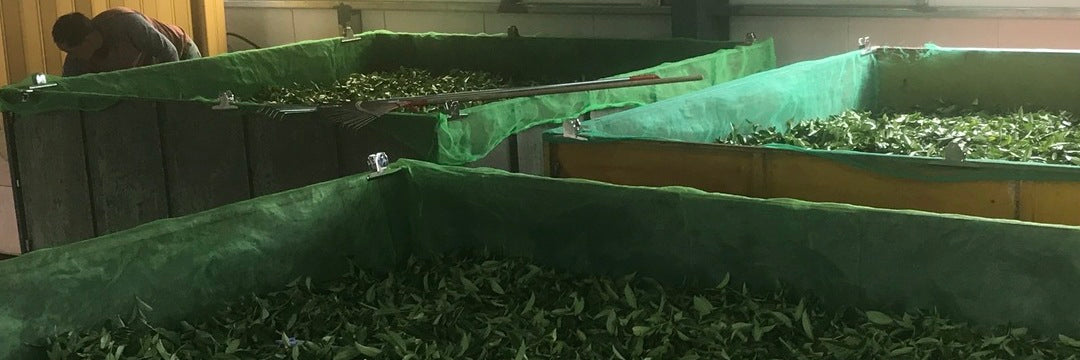
Batch 116 Wenshan Baozhong Spring Tea | Eco-Cha Tea Club

Batch 116 of the Eco-Cha Tea Club is a Wenshan Baozhong Spring Tea 2025 harvest. The photo above shows only a fraction of the awards that our ongoing source of this tea has won in the local competitions over the years. The photo in the lower center is his father with the first elected president of Taiwan in the late 1990's. Check the tasting notes blogpost with the tasting video for full details on how this tea brews up.
The day's harvest that we chose was meant to be entered into the largest of three local competitions, but a tea merchant advised its maker against it, saying that the quality standard for this year's competition was going for a slightly different profile. This was lucky for us, as we had a chance to procure it and share it with the tea club! It turns out that three other day's harvests from this same plot of tea achieved top awards in the smaller Shi Ding Farmers' Association. One got sixth place, and two other days placed within the top 2% of over 600 total entries!

Mr. Wang, the farmer we source from, said that his colleagues who were also competition players as well as tea judges concurred with him when they tasted the champion prize winner side by side with his sixth place prize. He said they all thought his was better. Very likely an after-the-fact sociological effect, but it reminded us of the scenario in the photo above. This is from several years ago when we walked into his tea room and he demanded that we taste the remaining dregs of cold tea in the bowls. We readily obliged, and were impressed by both teas that were quite similar in our perception. He then asked which one is better. We thought for a minute and chose one. He scowled. Only then did he reveal that the one we chose won champion prize, while the other was his entry was disqualified! The moral of the story is that tea competitions are a gamble to an extent. And while they undoubtedly serve a purpose in setting a quality standard with systematized methodologies that are designed to make them less fool proof — it's a subjective conclusion in the end.

We most appreciate Wenshan Baozhong Tea for its distinctive character. It's offers a fresh floral/herbal profile that sets it apart from any other lightly oxidized, unroasted tea we've tried. We also acknowledge its historical significance. Baozhong Tea was among the first teas to be exported from Taiwan to the West in the 19th century. Finally, we respect its relatively sustainable production methods that have developed in recent decades. The tea farms in the Taipei area are small family-run establishments that have been in existence for generations. They stand in contrast to the larger commercial farms to the south that developed in recent decades. Due to the disappearance of local labor force, almost all of this tea is machine harvested. This allows for timely harvesting in a much more cost effective way. This, in combination with professional destemming and sorting facilities preserves the quality at a lower cost.

An alternative processing method has also been effectively developed in the last 10-20 years. This is the initial withering of the leaves after being picked. The conventional method is called solar withering, where the freshly picked leaves are spread out on tarps — either outdoors or within greenhouse structures on the roofs of tea factories. This kickstarts the moisture depletion in the leaves, which is prerequisite to their partial oxidation. Another option to achieving the same effect is called hot wind withering. Whereas solar withering requires large spaces, and is susceptible to poor weather conditions, hot wind withering is an efficient alternative. Instead, the leaves are heaped into vented troughs equipped with heaters and fans to blow hot air through the leaves to initiate the withering process. This not only conserves space and solves the weather issue, it also can be done by one or two people instead of several.
The most definitive processing method involved in the making of Baozhong Tea that clearly distinguishes it from lightly oxidized Oolong Tea is that it is not tightly rolled. Baozhong is only gently curled, similar to Bi Luo Chun Green Tea. This maintains the integrity in the leaf structure that preserves the original compounds naturally occurring in the tea leaves. This is the most prominent aspect in the making of Baozhong Tea that puts it in a category of its own.
LET US KNOW!
Please post any questions or comments you may have in the comments section below!
SUBSCRIBE!
If you enjoyed this post and would like to hear more about the specialty tea industry here in Taiwan, follow us on YouTube, Facebook, and Instagram and please subscribe to our newsletter. Subscribe now and get US$5 off your first order.

